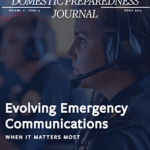Workplace violence often starts with a person(s) involved in a criminal activity or violent relationship who has access to a place of business. Despite intervention efforts, a disgruntled employee who was not properly vetted could pose a significant risk to the organization. When an organization begins preparing for a workplace violence prevention program it must first know what it is. The news often depicts workplace violence as associated with a disgruntled employee, but five types of workplace violence can occur. The first type of workplace violence occurs when an employee gets hurt in a criminal episode, such as a robbery, and no relationship exists between the victim and the suspect. The second type is the customer relationship, where a person involved would have legitimate business with the organization. The third type is where the suspect and victim are both employees of the organization (including former employees).
These three categories were initially considered the definitions of workplace violence. However, with more focus needed on the significant area of domestic-related incidents within workplace violence, Category Four was created – domestic violence relationship. This type can occur between a victim who is an employee and a suspect who is the victim’s spouse or former significant other. The suspect can be a current or former employee or someone that has no relationship with the business. Category five was also created for acts related to terrorism, where a company is attacked purely for ideological reasons.
According to threat assessments, active assailant attacks are more likely to occur in places of commerce than in schools, and attacks are increasing.
The Occupational Safety and Health Administration (OSHA) documents nearly two million workplace violence incidents each year. Workplace violence does not always include an attack, injury, or death. Workplace violence can include bullying, threats, intimidation, or any circumstance where a person causes fear or psychological trauma to an employee. It can also include a disturbance where an employee has difficulty completing their tasks. A little over one percent of reported workplace violence incidents result in injury. However, the vast majority of injuries were caused during robbery incidents.
History and Examples
Workplace violence is not a new concept, but it came to the forefront of American life in 1986 when a postal worker entered the post office where he worked with two handguns, killed 13 people, wounded six more, and then shot himself in the head. The shooter had numerous reprimands and was undoubtedly considered a disgruntled employee.
In 1987, a former employee of Pacific Southwest hijacked Flight 1771. Before he was fired, he was suspected of theft and narcotics transportation. As friends, family, and colleagues reported, he also had a suspected violent history. He was also suspected of being a narcotics dealer. The suspect used his airline credentials and previous passcodes to access the flight. He eventually took over the aircraft and crashed it. All 43 people on board were killed.
In December 2015, a food inspector in California and his wife killed 14 coworkers and wounded several more in San Bernardino, California. The food inspector was born in the United States and was of Pakistani descent, while his wife emigrated to the U.S. from Pakistan. The two were killed in a gunfight with law enforcement officers away from the initial scene. The suspect was considered a good employee and did not appear to have significant problems with anyone. However, it was later discovered the two suspects had ties to ISIS.
In 2018, an employee of T&T trucking kidnapped his ex-wife from her house after killing his 31-year-old daughter. He took his wife to his place of employment, where he confronted a male employee and killed him. The suspect then killed his ex-wife and chased another male who ran to a nearby business. The male that ran was shot and killed. The suspect left the scene and drove to a residence where he killed another male. The suspect believed his ex-wife cheated on him with some of the other victims.
This limited short list of examples shows that attacks are not a new phenomenon, and they can take place in a wide array of locations and methods of attacks for an unlimited number of reasons. Moreover, frequent news coverage of active assailant attacks is not limited to schools.
According to multiple sources, including threat assessment management information and the Occupational Safety and Health Administration (OSHA), active assailant attacks are more likely to occur in businesses and places of commerce rather than schools, and attacks are increasing. Many possible reasons for this include the attention schools receive in the media and the response after an incident. Additionally, many types of businesses and work functions make it more difficult for businesses and places of commerce to prepare as schools do.
Prevention
“They just snapped” and “No one could have predicted this” are common phrases heard after an incident. These assumptions were debunked before the Columbine High School incident when security specialist Gavin de Becker wrote The Gift of Fear. In the book, de Becker lists warning signs and pre-incident indicators. In the previous examples listed, none of those perpetrators “just snapped.” They provided warnings on multiple occasions to the people around them. However, most of those people thought the signs were something odd rather than something meaningful. The Cawood Organizational Assessment Grid, developed by James Cawood, and the concept of the Pathway to Violence as laid out in Threat Assessment and Management Strategies are more-recent tools to identify potentially violent people or incidents before they happen.
Formulating a threat assessment takes a trained professional. However, with some training, people can trust their instincts and what they see and help develop those thoughts when reporting to a supervisor or person trained in dealing with threats. Early intervention and early reporting are keys to prevention. Some warning signs may be people with significant life stressors such as financial issues, a death in the family, a spouse leaving, or something else. Other warning signs may be apparent mental health concerns, statements, or threats. Each warning sign by itself may not predict a future attack, and many people display some of these behaviors without ever doing anything to hurt another person. However, a trained threat assessor should take peer or witness reports, especially if the person of concern has a history of violence or demonstrates preparations for an attack.
This list of stressors, indicators, or warning behaviors is only a fraction of the potential warning signs. An organization should promote a speak-up culture, so everyone feels comfortable reporting potential dangers. By allowing free conversation and support, organizations can get help for the people of concern before an attack occurs. An organization should consider having a person dedicated to threat assessments and preparedness for both internal and external threats.
Prevention also includes hardening the target with proper security measures such as access control, camera systems, panic alarms, fortified walls, and secure parking lots. Ideally, a properly trained professional security force would assist in preventing and protecting personnel. However, these options may not always be available depending on cost, the type of business, the location, or the local building codes.
Preparations
One of the first steps in preparation is education. Information about active shooter events and workplace violence should not be used as a fear tactic but for educational purposes. Understanding that these are actual events and that the victims are people of every background, communities should encourage citizens and employers to take steps toward prevention and preparedness.
Employers should take a serious look at preparedness by including physical security measures, assessment protocols, and training. The U.S. Army Special Forces use the P.A.C.E. method when conducting operations, which stands for Primary, Alternate, Contingency, and Emergency. This methodology was developed for communications plans but can apply to daily business operations. Depending on the organization’s size, an employer could hire a full-time emergency planner that can cover a complete list of potential emergencies. The employer and the emergency planner can develop plans using the P.A.C.E. method as a guideline to set up evacuation and prevention strategies along with drills involving the entire staff. Employees should push to have these efforts if a business does not have them.
Other considerations are medical kits and trauma training for some of the employees. According to international security expert John Cameron, early medical access is one of the keys to proper preparedness, and immediate medical care is necessary for a tragic event. In addition, advanced training and drills help people stay calm during a crisis and better understand what to do.
A business has an obligation under OSHA to take measures to prevent violence. Still, individuals should also prepare rather than rely on the government, employers, or people of authority to save them. They need to address their own safety needs and can use the P.A.C.E. planning method as a place to start.
Individuals should learn organizational policies and understand what items they can and cannot have at work. Personal skills could include defensive training, medical and trauma training, and situational awareness training. There are a multitude of courses that teach situational awareness and threat assessment for the layperson to the professional. Continued training is critical. If it is not already being done, individuals can do the following:
- Cite real-world events and practice for events to encourage employers to take things seriously;
- Know where exits and first aid kits are;
- Make sure first aid kits are up to date with proper equipment; and
- Work with local law enforcement, and other first responders to encourage liaison and understanding of the organization.
Many aspects of preparedness can be overwhelming. However, starting a preparedness and prevention protocol is better than never addressing it. Moreover, remember that many organizations have been planning and preparing for a long time, along with local law enforcement and other first responders that would likely be willing to help develop a program and protocols.

Kevin Jones
Kevin Jones, CPP, is a school protection specialist and security manager. He spent nearly 20 years in law enforcement before starting work in a school district and more than a decade as a crisis and hostage negotiator. He was also a firearms instructor, investigator, and supervisor. Jones regularly conducts threat assessments and intelligence reports and is passionate about crisis intervention, de-escalation, and early intervention. He maintains his remote pilot license and has helped to develop and implement a drone unit with his previous organization.
- Kevin Joneshttps://domesticpreparedness.com/author/kevin-jones
- Kevin Joneshttps://domesticpreparedness.com/author/kevin-jones
- Kevin Joneshttps://domesticpreparedness.com/author/kevin-jones






